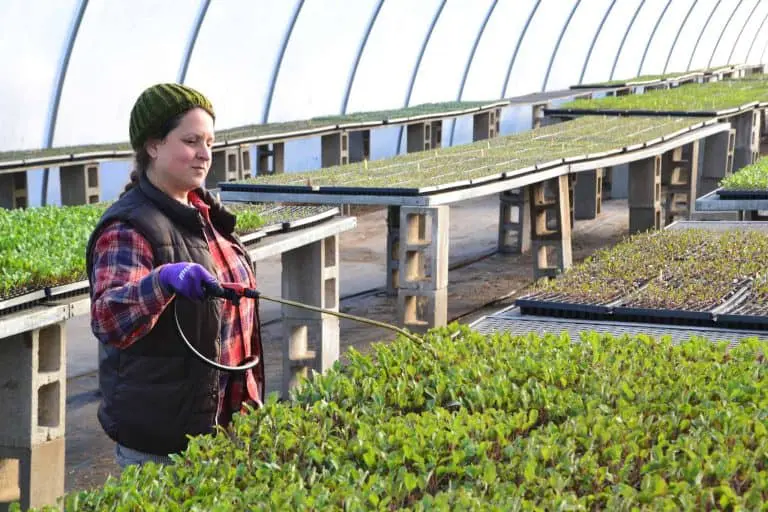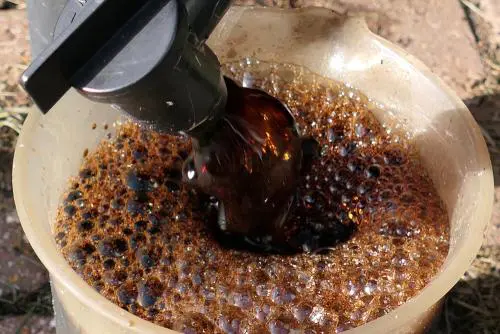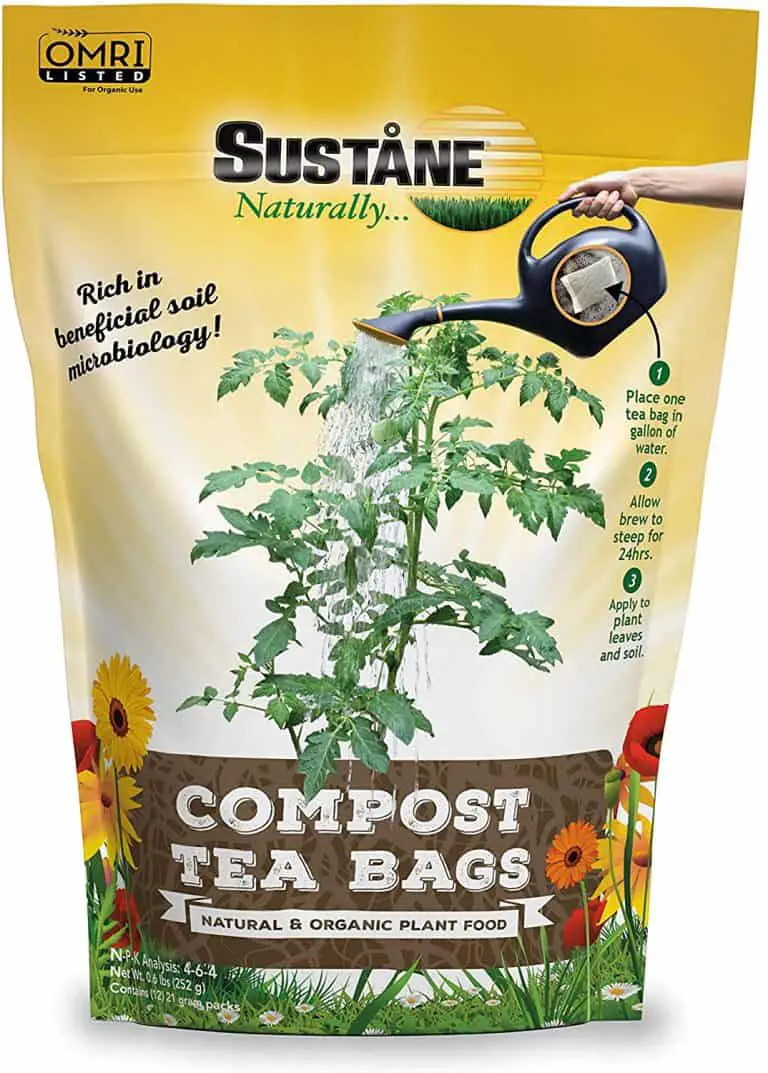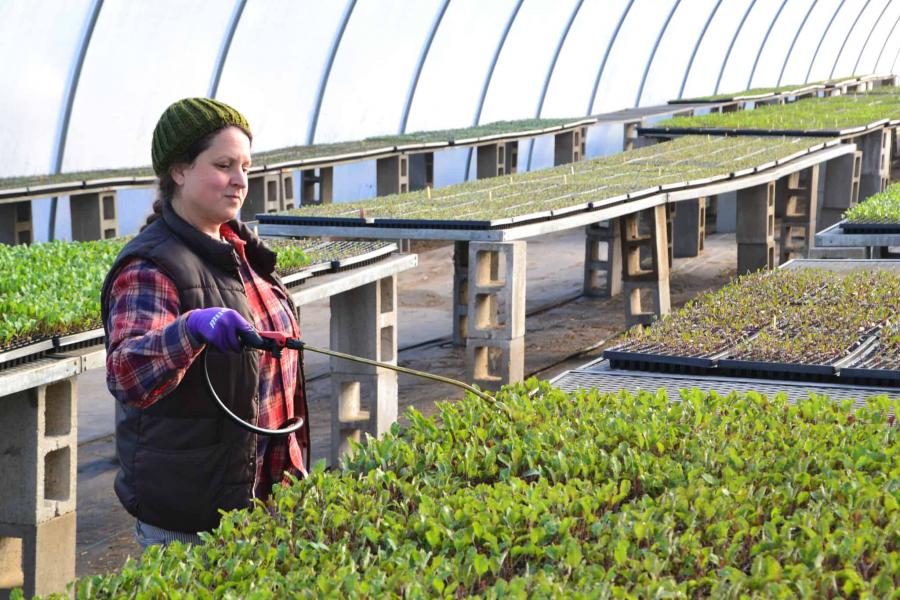You might be familiar with the term black gold, which is used to describe compost. Compost tea has a similar nickname – liquid gold.
It’s basically liquid compost on steroids. The brewing process multiplies the benefits of your compost and makes it super quick and easy to apply.
Many gardeners swear by the stuff, but it can be tricky to make. I take you through the best compost tea recipe for both non-aerated (without a pump) and aerated teas (with a pump).
What is compost tea?
Compost tea is a liquid fertilizer that contains billions of all the beneficial microorganisms and nutrients that were present in the compost used to make it. The liquid form means the concentrated tea is quickly and easily absorbed.
In simpler terms, it’s a nutritional drink for your plants.
The fermentation process draws out water-soluble nutrients and microbes such as bacteria, fungi, protozoa, and, if you’re lucky, nematodes from the compost. The microbes feed on whatever source of food you add, multiplying rapidly.

Brewing compost tea multiplies the good bacteria found naturally in finished compost.
There are two main types of compost tea: non-aerated compost tea and aerated compost tea.
The non-aerated version is much simpler to make but takes longer, and the results can be hit and miss. Aerated compost tea requires more attention, but you’ll get consistently good results.
What are the benefits of compost tea?
While there’s a lack of any substantial scientific evidence relating to the benefits of compost tea, there’s plenty of anecdotal evidence.
One of the reasons for the lack of scientific evidence is that it’s tough to study compost tea effectively. Batches can vary widely in both the microbes present and the concentrations. So what one study finds is almost impossible to replicate.
We know people who’ve had fantastic results using their organic compost tea – my mum is a huge fan!
Using our ultimate compost tea in your garden is said to have two main benefits:
- Increasing microbial activity in your soil food web and on the surface of your plants – this will help your plants to ward off pests and diseases
- Nourish soils and improve soil structure – this will increase aeration and water retention, as well as your plants nutrient uptake
The tea will help your flowers and vegetables reach their full potential without the need for any chemical fertilizers. Also, because the tea is more concentrated than the original compost, you need to use less compost to get the same effect.

Simple compost tea recipe without a pump
This is the most basic form of compost tea you can make and doesn’t require a pump. It’s straightforward and requires little effort but doesn’t always result in the best quality compost tea because it risks becoming anaerobic.
Stirring frequently helps to prevent this because it adds oxygen into the mixture which is vital for the microbes to survive.
If you want to use an aerator, we’ve outlined an aerobic compost tea recipe further down.
Ingredients
- 5-gallon bucket
- Non-chlorinated water (rainwater or tap water that’s been left to sit for 24 hours)
- High-quality, organic compost (this is a good use for compost balls from a compost tumbler)
Method
- Fill ⅓ of the bucket with your compost
- Fill the rest of the bucket with your non-chlorinated water
- Leave the mixture in a shady spot to steep for 5-6 days stirring frequently and vigorously
- Strain the mixture through a porous fabric such as a cheesecloth or an old shirt
- Dilute the liquid with water until it’s the colour of weak tea and use immediately
- Put the remaining solids back in your compost bin or use as mulch
What’s aerated compost tea?
Aerated tea is also known as actively aerated compost tea (AACT) or aerobic compost tea (ACT).
It’s a compost tea that’s been brewed with a constant supply of oxygen via and air pump. The beneficial microbes we want to thrive prefer aerobic conditions. By providing lots of oxygen, we’re encouraging the right sort of bacteria to grow.
Most people choose to make aerated compost tea. This is mainly because without a constant supply of oxygen, the tea risks becoming overrun with anaerobic bacteria which can be harmful to plants.
Stirring the mixture does supply some oxygen, but not as much as using a pump.
Aerated compost tea recipe with DIY brewer
You can buy special aerated brewing kits online, but in this ultimate compost tea recipe, we show you how to make a DIY compost tea brewer and then how to brew the tea.
Materials you’ll need for a DIY home brewer
- 5 gallon bucket
- Air stones and air pump (or fish tank aerator)
- Brewing bag / porous cloth material
Ingredients for compost tea
- 2-4 cups of high-quality, organic compost (aerobic or worm castings)
- 4-5 gallons of non-chlorinated water (rain water or tap water that’s been left to sit for 24 hours)
- 2-3 tablespoons of catalyst (food source for the microbes, i.e humic acid or fish hydrolysate)
The compost
You’ll notice we specified high-quality compost. The compost you use will determine the quality and composition of your compost tea. You’ll only find microbes that were already present in the inoculant in the final mixture, so you want to be using a biologically diverse compost.
The best compost tea recipe will use vermicompost or compost that you’ve made using aerobic conditions. If vermicompost is used, the tea is usually referred to as worm tea or worm casting tea.
To further increase the diversity of the tea, some people recommend adding a handful of garden soil or forest soil along with the compost.
Always make sure you use finished compost, especially if the compost contains any human or pet waste. If you don’t, harmful pathogens present in the unfinished compost can multiply in your compost tea.
The catalyst
The catalyst you add is also an essential consideration because different microbes feed on different foods. To make a well-balanced microbial tea, you should add various food sources to keep both the bacteria and fungi happy.
Bacteria like to feed on simple sugars such as maple syrup or unsulphured black molasses.
Fungi prefer more complex sugars which you can get from things like oatmeal, fish hydrolysate (pulverised fish), kelp meal or humic acid.
If you want to brew a more bacteria or fungi heavy tea, then you can adjust the amounts of food you add. It also helps to have created good compost that’ll be rich in whatever microbe you want to dominate your tea. For example, if you want to make fungal dominated compost you can use wood chips.
Bacterial dominated compost tea is good for treating yeast infections and using on brassicas plants. Fungal compost tea recipes are suitable for coniferous trees and managing blight.
Method for our ultimate compost tea recipe

1) Set up the aerator in the bucket
First, you’ll need to set up the pump and aerator.
For this, you’ll need an electrical outlet so consider this when you decide where to keep the tea.
Aim for somewhere with a consistent temperature. A temperature similar to where you plan to use the compost tea is best. Microbes are temperature sensitive, so if you brew the tea somewhere cold and then apply it in a hot greenhouse, the bacteria will die off very quickly.
2) Dechlorinate the water if using tap water
Most tap water contains chlorine which is great for drinking water but bad for making compost tea. Chlorine will kill off any bacteria which starts to grow.
You can dechlorinate water by leaving it to sit in a bucket for 24 hours, or by aerating it with your pump for a few hours.
If you’re using rain water, you can skip this step.
3) Place the compost in your brewing bag and then in the bucket
You can put the compost straight in the bucket, or you can put the compost in a mesh bag to create a big ‘compost tea bag’ and then place this in the bucket.
We like to use a tea bag method because it means you don’t have to strain the mixture when it’s done – it’s already separated. It also helps to keep your bucket clean.
A 400-micron mesh bag is best because it allows all the beneficial bacteria and fungi to flow freely. But if you don’t have one of these, you can substitute it with old nylon stockings or a cheesecloth.
Make sure you have some way of retrieving the bag without touching the tea. For example, you can tie a long rope around it.
4) Fill the rest of the bucket up with your water
Leave a little bit of room at the top to avoid spillage when you’re stirring.
5) Add the catalyst to the mixture
Any catalyst you use should be water-soluble. So place these straight in the water and give it a good stir.
6) Turn the pump on and let it steep for 24-36 hours stirring every 24 hours
Leave the tea to brew for between 24-36 hours.
If you’re aiming for bacterial domination, then use a shorter brewing time. Fungi take longer to develop so leave the compost to steep longer of you want high fungal concentrations.
Your mixture might start to foam. This is normal, but if it’s overflowing then try adding some vegetable oil and this should reduce the foaming.
The best way to tell if your tea is ready or not is to smell it. If it smells subtle and earthy, then go ahead and use it. If it still smells like it did at the beginning of the process (i.e. of molasses) then leave it for a bit longer.
If it doesn’t smell right or has notes of ammonia, then something has gone wrong. Discard the batch and start again.
7) Remove the bag / Strain the tea
When you think the tea is ready, you can remove the bag of compost.
If you didn’t use a tea bag, you’ll have to strain the mixture through a porous material to collect the liquid. Again a 400 micrometer mesh is best, but you can use an old shirt if it’s all you have.
You can put the leftover solids back into your compost bin, or you can use it as mulch around your plants.
8) Use the tea as soon as possible
For best results use the mixture immediately or very soon after it’s finished brewing. If you leave the tea too long, then the microbes will start to die off, and the tea will become ineffective.
Always smell the tea before you use it. If it smells off, don’t use it.
9) Clean the equipment
When you’re done make sure you clean the equipment before you make the next batch of tea so anaerobic bacteria doesn’t start to grow on it.
You can clean it with dilute hydrogen peroxide and use baking soda as a scrub.
How to use compost tea?
Once you’ve made the ultimate compost tea, there are two main ways you can use it.
As a soil drench
You can pour the compost tea directly onto the soil around your plants. This will add all the beneficial microbes in the compost tea to your soil food web.
You don’t have to dilute the tea to do this unless you’re using it on particularly delicate or new plants. Then we suggest diluting it up to a 10:1 ratio with water.
Adding some extra water will also help make sure the tea permeates the soil down to the roots of your plants.
For best results, you should apply at regular intervals, such as every month.
It’s also particularly beneficial to use the compost tea just before planting, or at the first sign of any sort of disease.
As a foliar spray (leaf spray)
The idea behind this is that if you spray enough good bacteria on your plants, they will overwhelm any bad bacteria and prevent disease.
Before you use it as a foliar spray, you should dilute the mixture with a ratio of 1 part tea to 10 parts water (dechlorinated). The liquid should be the colour of weak tea before you apply it.
Aim for full coverage, and avoid spraying in the middle of the day when the sun is at its strongest and can burn the leaves. Early morning or late evening is best.
Some people add a few drops of vegetable oil to their spray bottle to help the liquid stick to the leaves.
In hydroponics
Compost tea can act as a replacement, or a supplement to the shop-bought nutrient concentrates that growers use in their hydroponic systems. Compost, or worm tea, is organic and less expensive than the commercially available options.
Before you add the compost tea into your hydroponic system make sure it’s really well strained because any bits of stray debris can cause clogs in the drip holes.
Also, be aware that the nutrient levels in compost tea will vary from batch to batch, which can make it hard to monitor exactly what nutrients your plants are getting. Watch your plants closely and be ready to give them extra nutrients if you see any signs of deficiencies.
Other types of compost tea
There are plenty of other types of tea that can be used as organic fertilizer, but they use different inoculants so have different properties.
Leachate
People will often assume that leachate, which is the liquid that seeps out of your compost, is the same as compost tea. It’s not.
Leachate forms as water makes its way through your compost heap or worm composting bin picking up soluble nutrients as it goes.
Because it contains nutrients, you can use it as a mild fertilizer, but be aware that it’s anaerobic so could contain potentially harmful bacteria. Also, it doesn’t contain the valuable microbes that you cultivate in compost tea.
Leachate is commonly collected from worm composting bins, and you’ll see it referred to as worm tea. But if it hasn’t been made using the recipe above, then it’s still just compost juice.
You can also collect a nutrient-rich form of leachate from Bokashi, which is a popular urban composting method.
Manure tea
This is the original compost tea. But, as the name suggests, it’s made using manure instead of finished compost in your tea bag.
The tea is commonly used by farmers to fertilizer their crops when they don’t want to rely on chemicals.
Plant tea
Plant tea, or herb tea, is like compost tea but plants are used as the inoculant rather than compost. Plants can contain valuable nutrients which can be drawn out during the brewing process.
You can use any plants you have handy (including weeds!), but some are more beneficial than others.
Stinging nettles, alfalfa, horsetail, willow, comfrey, dandelions and grass clippings are all examples of plants that are high in important nutrients such as potassium and vitamin A.
Compost extract
Compost extract is another thing people commonly mistake for compost tea. It’s more similar to leachate than compost tea.
Making compost extract does involve soaking compost in water, but only for a few hours rather than days. It aims to extract any soluble nutrients from the compost but doesn’t encourage microbial growth so the mixture won’t be biologically active.
An advantage to compost extract is that it can be stored for much longer than compost tea because it’s not supporting any life.
Commercial microbial tea
These are ready-made compost tea bags. You just need to add water.
Because you can’t keep compost tea for long, it can be hard to make sure you have a consistent supply. You can keep most tea bags for up to a year, so they’re always useful to have as a backup.

You can even buy specially formulated teas for specific plants or problems.
Summary
Hopefully you’ve been able to follow this compost tea recipe and have successfully created some of your very own liquid fertilizer!
Make sure to let us know how it’s transformed your garden.
